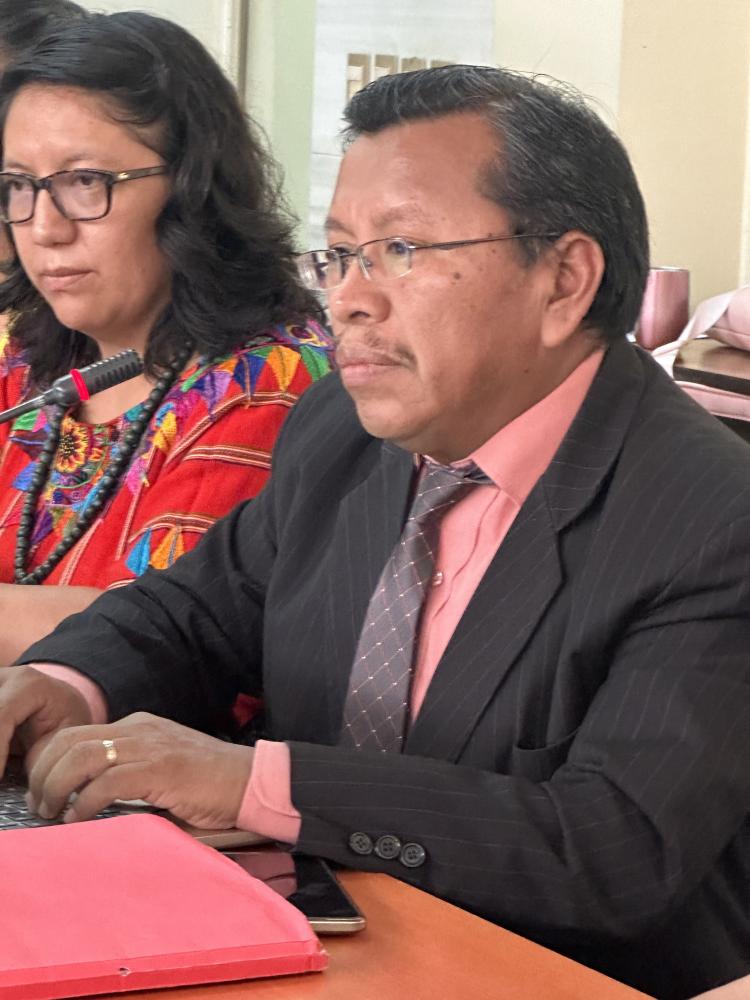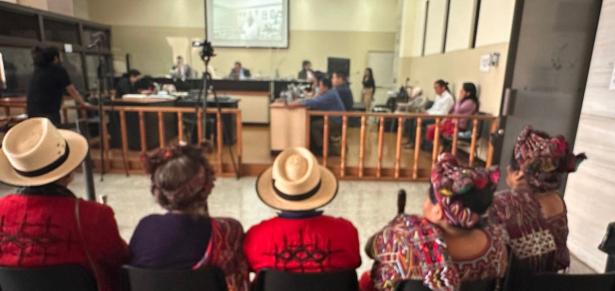As the genocide trial of retired Guatemalan General Benedicto Lucas Garcia unfolds in a courtroom in Guatemala City, Indigenous Maya witnesses—some in strained voices or reduced to tears—describe the killing methods used by soldiers. A woman in a woven huipil blouse grabs her chest and inclines forward to show how her mother was shot point blank. A man who was fourteen when troops came upon his family cleaning their cornfield points to his forehead and a spot above his right ear where a soldier shot his father “in front of me.” Another woman closes her fingers like the head of an ax and brings it down on the crown of her head to show how a neighbor was killed.
As testimonies unroll, it is germane to point out that Benedicto Lucas Garcia did not commit mass murder by himself, but rather with help from the United States and Israel.
Lucas, now ninety-one, Armed Forces Chief of Staff for his brother, President General Fernando Romeo Lucas Garcia, was the architect of the counterinsurgency in a war from 1960 to 1996 in which 200,000 died or disappeared, 93 percent of them at the hands of the state according to a United Nations-sponsored Truth Commission report. Genocide trials are rare, partly because of the difficulty of proving that the accused intended to destroy a particular group as such. Lucas is charged with deliberately seeking to eliminate Indigenous Maya in the Ixil Triangle, located in the remote mountainous region of Quiche, among the hardest hit during the war.

From the time of the 1954 CIA-orchestrated coup against the progressive, democratically elected president, Jacobo Árbenz, Guatemala was led by military autocrats supported by the United States, or civilians answerable to the military. (Only in January, 2024 did another progressive, independent thinking president, Bernardo Arévalo, take office, although he continues to fight the old military guard and rightists in the business and legal sectors.) After the CIA coup, young officers rebelled in 1960 when the Guatemalan president at the time, a general, allowed Washington to train fighters for the Bay of Pigs invasion on a local plantation. Fidel Castro was a hero to many Latin Americans for throwing off the U.S. yoke; permitting the U.S. military to instruct the Cuban invaders inside Guatemala was an affront to national sovereignty.
Unsuccessful, the insurgents fled to the eastern Zacapa region and began a guerrilla movement aiming to overthrow the government. Washington sent in Green Berets to advise, and by some reports to fight alongside Guatemalan troops. They pursued the rebels mercilessly, used napalm, and slaughtered civilians suspected of being guerrilla supporters. In 1972 a handful of surviving insurgents regrouped as the Guerrilla Army of the Poor (EGP) and entered the Quiche region by way of Mexico. The EGP gathered thousands of supporters, including in the Ixil Triangle. Meanwhile in Guatemala City, U.S. advisors, many fresh from Vietnam, reshaped Guatemalan police and intelligence procedures. Death squads killed opposition student, church, and union leaders. In 1977 the human rights situation in Guatemala was so bleak that U.S. President Jimmy Carter stopped military aid.
But there was another source of weapons and advisors: Israel, “the only country that gave us support in our battle against the guerrillas,” Benedicto Lucas said, as foreign correspondent Yoav Karni reported in 1986 in the Israeli newspaper Ha’aretz.

Yet Israel should not be considered a mere proxy for the United States during Lucas’s genocidal sweeps through the Ixil. Israel was a war machine on its own, searching for arms markets and anxious for allies. Tel Aviv supported the brutal Guatemalan army in Lucas’s day and beyond.
Israel began selling weapons to Guatemala in 1974: armored personnel carriers, military communications equipment, light cannons, machine guns, Uzis, and thousands of Galil assault rifles, which became the Guatemalan troops’ standard weapon. In the 1980s Israel built a factory inside Guatemala to produce the Galils and bullets to go with them. Tel Aviv made deliveries of its signature short take-off and landing aircraft, the Arava, several of which were later equipped with gun pods.
“The planes came over us,” testified Caterina Rodriguez, now seventy-one, recounting the year she spent sheltering in the mountains with her husband and a brother, watching others die of starvation, eating grass after Guatemalan soldiers wiped out residents of their village and burned its houses to cinders. “The planes dropped bombs . . . we were like animals looking for places to hide,” she said in the courtroom.
Various news media reported that Lucas said Israeli advisors were teaching locals how to use the Israeli equipment the army had purchased. But they did much more. By 1983, when the regime of Lucas’s brother had given way to another autocrat, General Efraín Ríos Montt, the EGP said there were 300 Israeli advisors in the country, “in the security structures and in the army.”
“Israeli advisers—some official, others private—helped Guatemalan internal security agents hunt underground rebel groups,” reported correspondent Ed Cody for The Washington Post that year.
An Israeli company, then called Tadiran, designed and financed the Guatemalan army’s school of transmission and electronics. At the school’s opening celebration, Lucas thanked the Israeli ambassador for “the advice and transfer of electronic technology” which brought the country up to date, and the ambassador called Guatemala “one of our best friends.” A computer supplied by Israel and housed in a former military academy became “the nerve center of the armed forces, which deals with the movements of units in the field and so on,” Lucas said. Once the army’s presence was secure in an area, Maya were concentrated into controlled settlements. Israelis advised on those as well.
Dr. Milton Jamail, a scholar who has examined the Israel-Guatemala connection and traveled in the country during the war, wrote in the 1986 book It’s No Secret, Israel’s Military involvement in Central America that the Guatemalan government, “in facing a broad based popular movement, has come to resemble the Israelis on the West Bank and Gaza: They are an occupying army.” To stop dissent, “they must use force, but also need to plan for the more long-range effort of social control. Thus the Israeli plans at home provide a prototype for solving Guatemalan problems.”
At the end of their testimonies, witnesses in the genocide trial are asked what they want from the tribunal by lawyers of the Public Ministry, which is prosecuting the criminal case for the government, or by lawyers from the plaintiffs, the Human Rights Office of the Archdiocese of Guatemala and the Association for Justice and Reconciliation, a victims’ group.
The witnesses usually answer with some version of the words of Juana Avilés, who was fifteen when she ran at the appearance of soldiers and later returned to find her parents dead and her house destroyed. “What obligates me is the pain I carry,” Avilés said. “I do not want my children to suffer like this.”
[Mary Jo McConahay's latest book is "Playing God: American Catholic Bishops and the Far Right" (Melville House).]


Spread the word